2003 PONTIAC BONNEVILLE stop start
[x] Cancel search: stop startPage 232 of 418
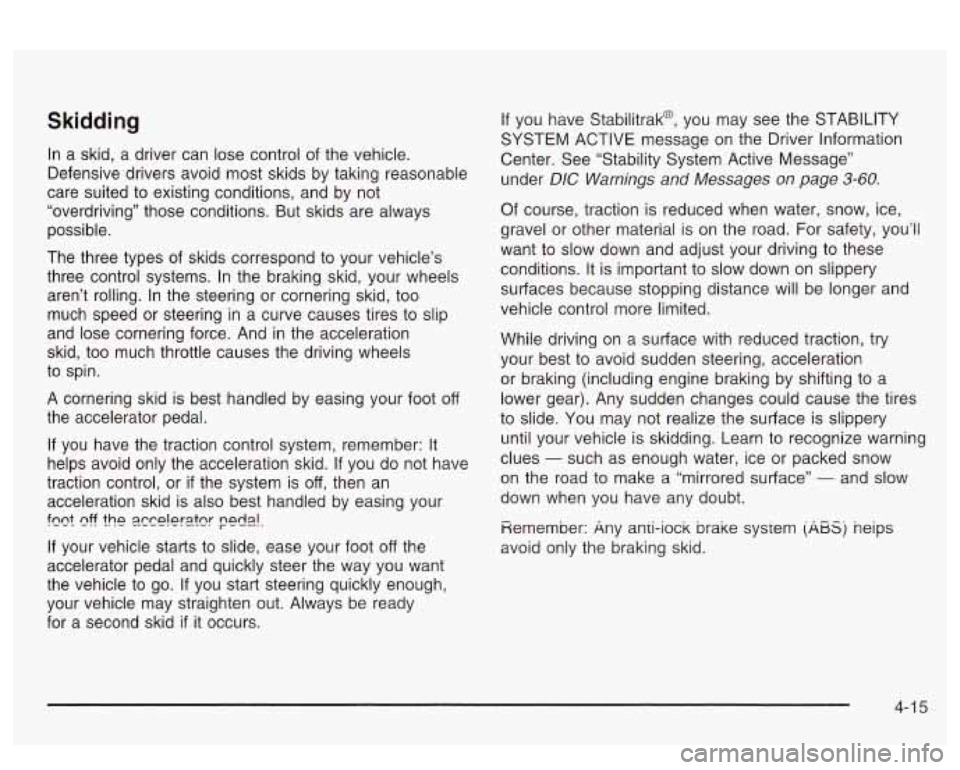
Skidding
In a skid, a driver can lose control of the vehicle.
Defensive drivers avoid most skids by taking reasonable
care suited to existing conditions, and by not
“overdriving” those conditions. But skids are always
possible.
The three types of skids correspond to your vehicle’s
three control systems. In the braking skid, your wheels
aren’t rolling. In the steering or cornering skid, too
much speed or steering in a curve causes tires to slip
and lose cornering force. And in the acceleration
skid, too much throttle causes the driving wheels
to spin.
A cornering skid is best handled by easing your foot off
the accelerator pedal.
If you have the traction control system, remember: It
helps avoid only the acceleration skid.
If you do not have
traction control, or
if the system is off, then an
acceleration skid is also best handled by easing your
!CQ! nff !he 2cce!er2!cr ped?!.
If your vehicle starts to slide, ease your foot off the
accelerator pedal and quickly steer the way you want
the vehicle
to go. If you start steering quickly enough,
your vehicle may straighten out. Always be ready
for a second skid
if it occurs.
If you have Stabilitrak@, you may see the STABILITY
SYSTEM ACTIVE message on the Driver Information
Center. See “Stability System Active Message”
under
DIC Warnings and Messages on page 3-60.
Of course, traction is reduced when water, snow, ice,
gravel or other material is on the road. For safety, you’ll
want to slow down and adjust your driving
to these
conditions. It is important to slow down on slippery
surfaces because stopping distance will be longer and
vehicle control more limited.
While driving on a surface with reduced traction, try
your best to avoid sudden steering, acceleration
or braking (including engine braking by shifting to a
lower gear). Any sudden changes could cause the tires
to slide. You may not realize the surface is slippery
until your vehicle is skidding. Learn to recognize warning
clues
- such as enough water, ice or packed snow
on the road to make a “mirrored surface”
- and slow
down when you have any doubt.
Fiemember: Any anii-iock brake sysiem (AESj neips
avoid only the braking skid.
4-1 5
Page 235 of 418
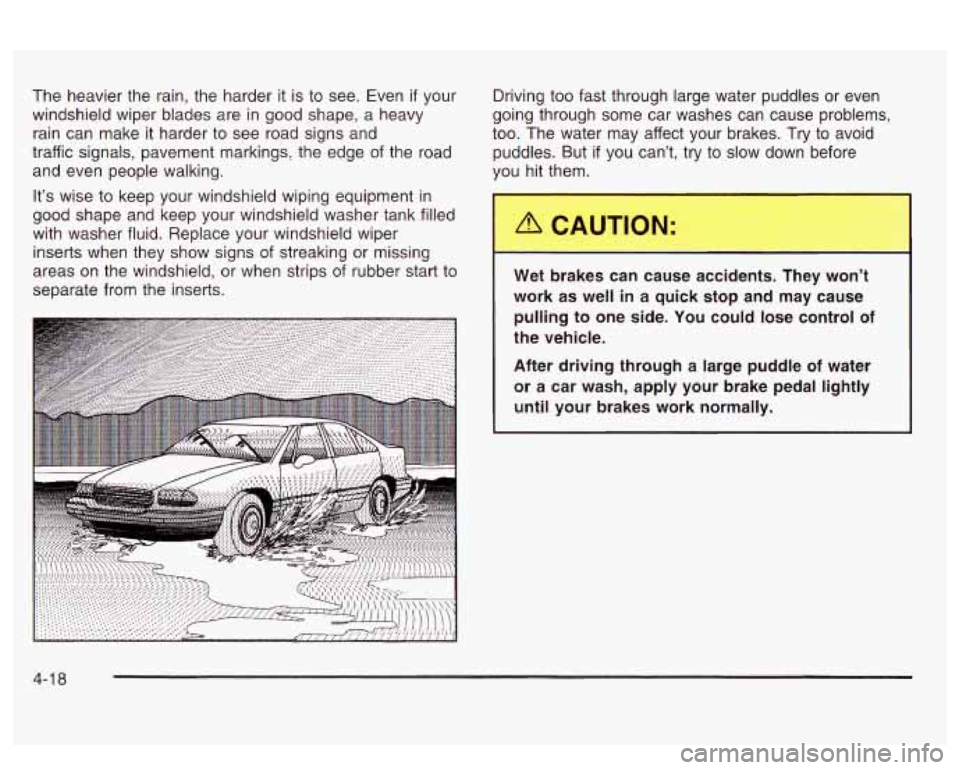
The heavier the rain, the harder it is to see. Even if your
windshield wiper blades are in good shape, a heavy
rain can make it harder to see road signs and
traffic signals, pavement markings, the edge
of the roaa
and even people walking.
It’s wise to keep your windshield wiping equipment in
good shape and keep your windshield washer tank filled
with washer fluid. Replace your windshield wiper
inserts when they show signs of streaking or missing
areas on the windshield, or when strips of rubber start to
separate from the inserts. Driving too fast through large
water puddles or even
going through some car washes can cause problems,
too. The water may affect your brakes. Try to avoid
puddles. But if you can’t, try to slow down before
you hit them.
Wet brakes can cause accidents. They won’t
work as well in a quick stop and may cause
pulling to one side. You could lose control of
the vehicle.
After driving through a large puddle
of water
or a car wash, apply your brake pedal lightly
until your brakes work normally.
4-1 8
Page 239 of 418
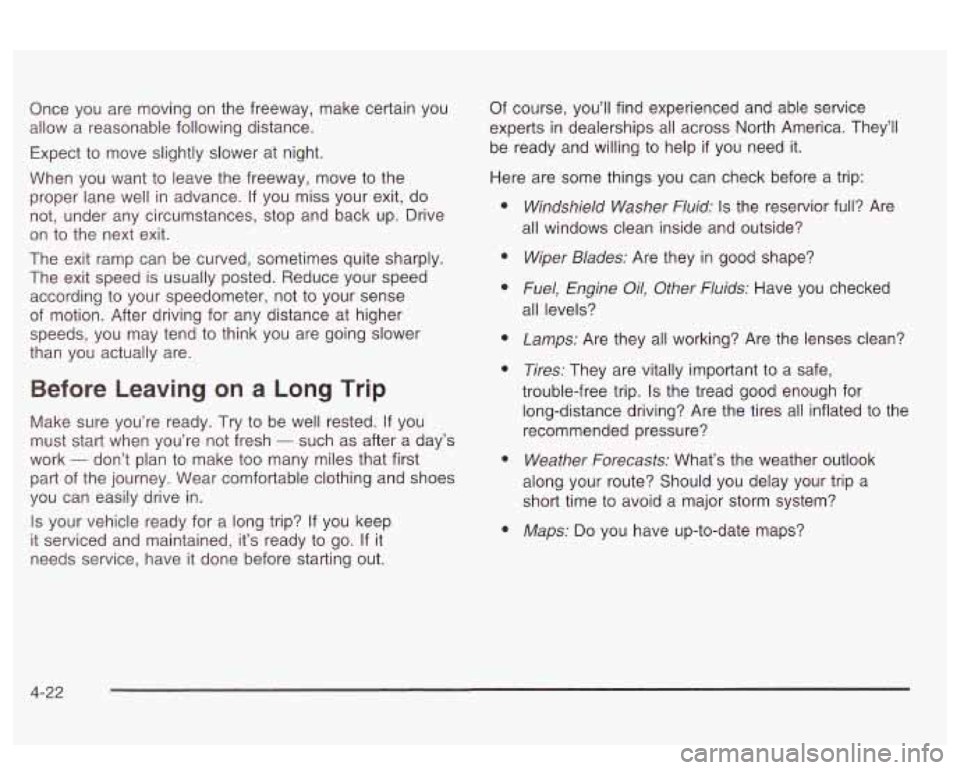
Once you are moving on the freeway, make certain you
allow a reasonable following distance.
Expect to move slightly slower at night.
When you want to leave the freeway, move to the
proper lane well in advance.
If you miss your exit, do
not, under any circumstances, stop and back up. Drive
on to the next exit.
The exit ramp can be curved, sometimes quite sharply.
The exit speed is usually posted. Reduce your speed
according to your speedometer, not to your sense
of motion. After driving for any distance at higher
speeds, you may tend to think you are going slower
than you actually are. Of
course, you’ll find experienced and able service
experts in dealerships all across North America. They’ll
be ready and willing to help
if you need it.
Here are some things you can check before a trip:
a
Before Leaving on a Long Trip
Make sure you’re ready. Try to be well rested. If you
must start when you’re not fresh
- such as after a day’s
work
- don’t plan to make too many miles that first
part of the journey. Wear comfortable clothing and shoes
you can easily drive in.
Is your vehicle ready for a long trip? If you keep
it serviced and maintained, it’s ready to go. If it
needs service, have it done before starting out.
Windshield Washer Fluid: Is the reservior full? Are
all windows clean inside and outside?
Wiper Blades: Are they in good shape?
Fuel, Engine Oil, Other Fluids: Have you checked
all levels?
Lamps: Are they all working? Are the lenses clean?
Tires: They are vitally important to a safe,
trouble-free trip.
Is the tread good enough for
long-distance driving? Are the tires all inflated
to the
recommended pressure?
Weather Forecasts: What’s the weather outlook
along your route? Should you delay your trip a
short time to avoid a major storm system?
Maps: Do you have up-to-date maps?
4-22
Page 258 of 418
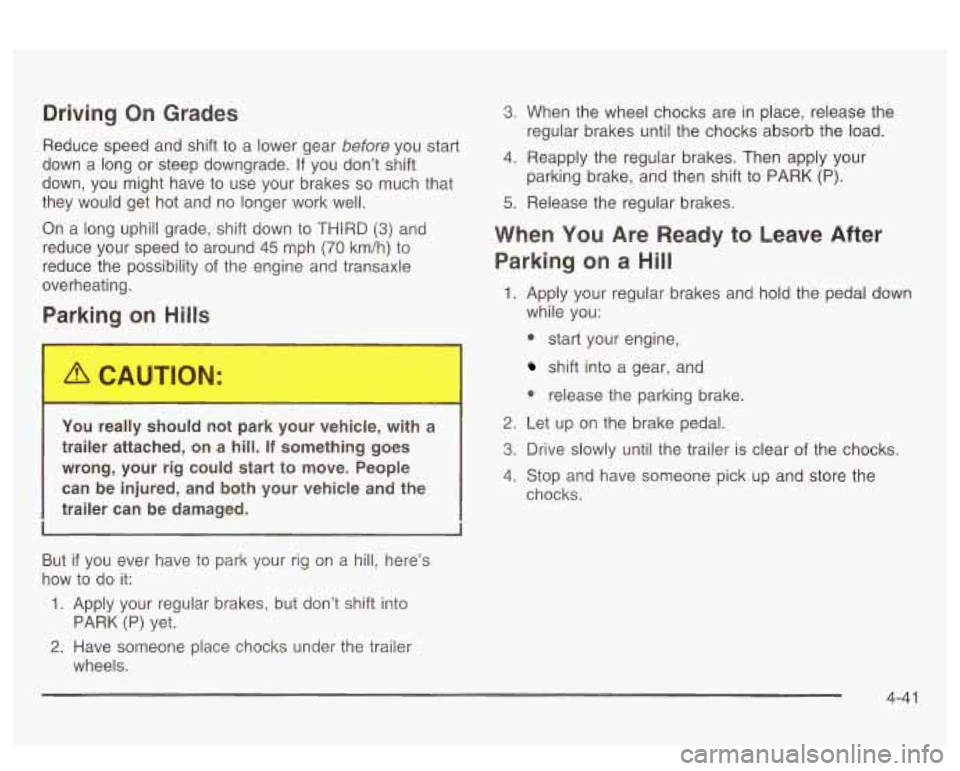
Driving On Grades
Reduce speed and shift to a lower gear before you start
down a long or steep downgrade. If you don’t shift
down, you might have to use your brakes
so much that
they would get hot and no longer work well.
On a long uphill grade, shift down to
THIRD (3) and
reduce your speed to around 45 mph
(70 km/h) to
reduce the possibility
of the engine and transaxle
overheating.
Parking on Hills
You really should not park your vehicle, with a
trailer attached, on a hill.
If something goes
wrong, your rig could start
to move. People
can be injured, and both your vehicle and the
trailer can be damaged.
But if you ever have to park your rig on a hill, here’s
how to
do it:
1. Apply your regular brakes, but don’t shift into
2. Have someone place chocks under the trailer
PARK (P) yet.
wheels.
3. When the wheel chocks are in place, release the
regular brakes until the chocks absorb the load.
4. Reapply the regular brakes. Then apply your
parking brake, and then shift to PARK (P).
5. Release the regular brakes.
When YQU Are Ready to Leave After
Parking on a Hill
1. Apply your regular brakes and hold the pedal down
while you:
* start your engine,
shift into a gear, and
0 reiease the parking brake.
2. Let up on the brake pedal.
3. Drive slowly until the trailer is clear of the chocks.
4. Stop and have someone pick up and store the
chocks.
4-41
Page 260 of 418
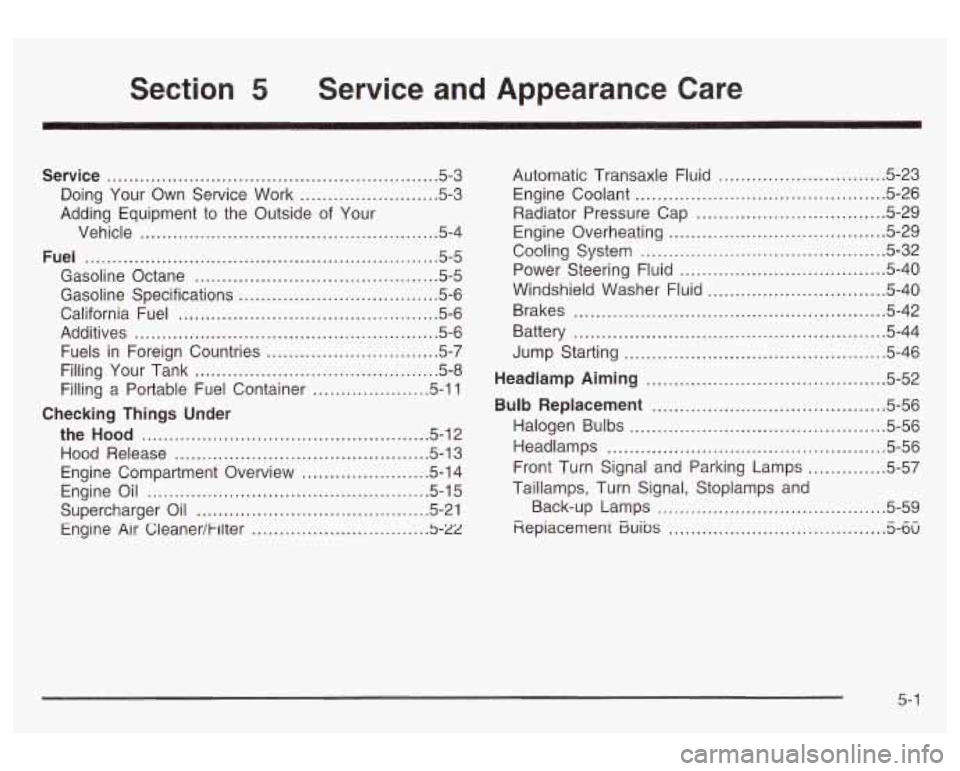
Section 5 Service and Appearance Care
Service ........................................................ 5.3
Doing Your Own Service Work
......................... 5.3
Adding Equipment to the Outside
of Your
Vehicle
...................................................... 5.4
Fuel ................................................................ 5.5
Gasoline Octane
............................................ 5.5
Gasoline Specifications
.................................... 5.6
California Fuel
............................................... 5.6
Additives
....................................................... 5.6
Fuels in Foreign Countries
............................ 5.7
Filling Your Tank
........................... .......... 5.8
Filling
a Portable Fuel Container ..... .... 5.11
the Hood ............................. .... 5.12
Hood Release
.............................. ........ 5.13
Engine Compartment Overview ...................... -5-1 4
Checking Things Under
Engine Oil ................................................... 5.15
Supercharger Oil .......................................... 5.21
Engine Air Cleaner/t-llter
................................ 5-22
Automatic Transaxle Fluid .............................. 5.23
Engine Coolant
............................................. 5.26
Radiator Pressure Cap
.................................. 5.29
Engine Overheating
....................................... 5.29
Cooling System
............................................ 5.32
Power Steering Fluid
..................................... 5.40
Windshield Washer Fluid
................................ 5.40
Brakes
........................................................ 5.42
Battery
........................................................ 5-44
Jump Starting
............................................... 5-46
Headlamp Aiming .......................... ...... 5.52
Bulb Replacement .................................. -5-56
Halogen Bulbs
.............................................. 5.56
Headlamps
.................................................. 5.56
Front Turn Signal and Parking Lamps
.............. 5-57
Taillamps, Turn Signal, Stoplamps and
Back-up Lamps
......................................... 5-59
fiepiacement
Euibs 3.w - ^^ .......................................
5- I
Page 412 of 418
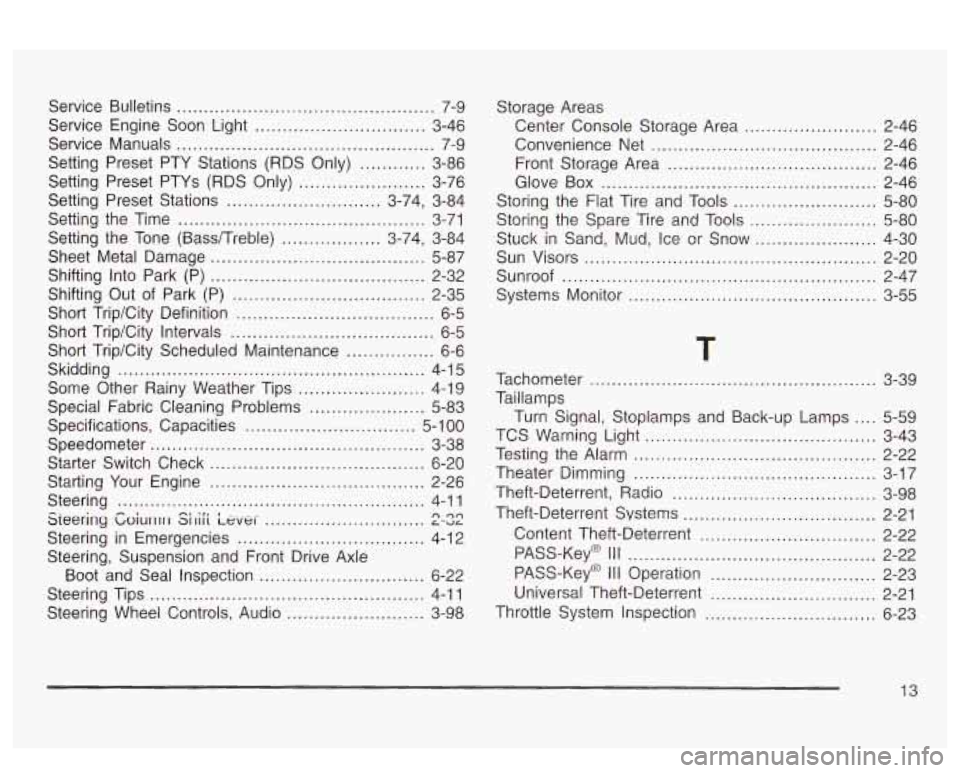
Service Bulletins .............................. ..... 7-9
Service Engine Soon Light
............................... 3-46
Service Manuals
............................................... 7-9
Setting Preset PTY Stations (RDS Only)
............ 3-86
Setting Preset PTYs (RDS Only)
....................... 3-76
Setting Preset Stations
............................ 3-74, 3-84
Setting the Tone (Bass/Treble)
.................. 3-74, 3-84
Shifting Into Park (P)
....................................... 2-32
Setting the Time
............................................. 3-71
Sheet Metal Damage
....................................... 5-87
Shifting Out of Park (P)
................................... 2-35
Short Trip/City Definition
.................................... 6-5
Short Trip/City Scheduled Maintenance
................ 6-6
Skidding
........................................................ 4-1 5
Some Other Rainy Weather Tips ....................... 4-19
Special Fabric Cleaning Problems
................. 5-83
Specifications, Capacities
............................ 5-1 00
Speedometer .................................................. 3-38
Starter Switch Check
....................................... 6-20
Steering
........................................................ 4-1 1
Steering in Emergencies .................................. 4-12
Boot and Seal Inspection
.............................. 6-22
Steering Wheel Controls, Audio
......................... 3-98
Short Trip/City
Intervals
..................................... 6-5
Starting Your Engine
....................................... 2-26
Steering
&urrlrl 31111~ ieveI L-JL
Steering, Suspension and Front Drive Axle
Steering Tips
.................................................. 4-1 1
A -I .I. r) r)r) .............................
Storage Areas
Center Console Storage Area
........................ 2-46
Convenience Net
......................................... 2-46
Front Storage Area
...................................... 2-46
Glove Box .............................................. 2-46
Storing the Spare Tire and Tools
....................... 5-80
Sun Visors
..................................................... 2-20
Sunroof
......................................................... 2-47
Systems Monitor
.......................................... 3-55
Storing the Flat Tire
and Tools
...................... 5-80
Stuck in Sand, Mud, Ice or Snow ...................... 4-30
..... 3-39
Tachometer ................................ ~ ~ ~ ~ ~
Taillamps
Turn Signal. Stoplamps and Back-up Lamps
.... 5-59
TCS Warning Light
.......................................... 3-43
Testing the Alarm
............................................ 2-22
Theater Dimming
............................................ 3-17
Theft-Deterrent, Radio
..................................... 3-98
Theft-Deterrent Svstems
................................... 2-21
Content Theft-Deterrent
................................ 2-22
PASS-Key@
Ill ............................................. 2-22
PASS-Key@
Ill Operation .............................. 2-23
Universal Theft-Deterrent
.............................. 2-21
Throttle System Inspection
............................... 6-23
13